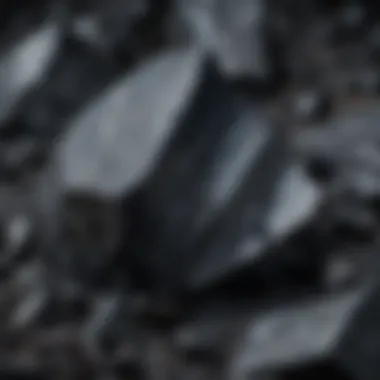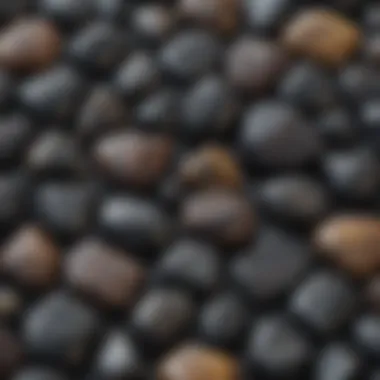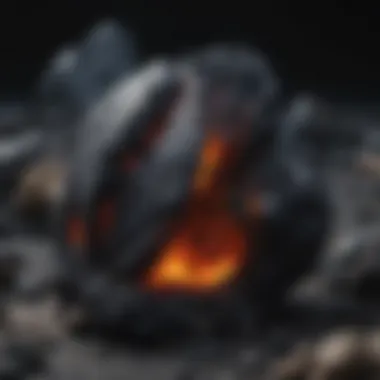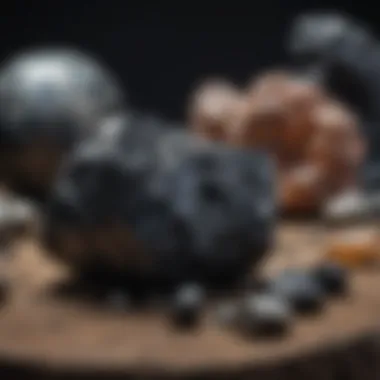Identifying Obsidian: A Complete Collector's Guide


Intro
Obsidian, a naturally occurring volcanic glass, captures the attention of collectors and geologists alike. Its unique characteristics and diverse forms make it not just a subject of interest but a valuable addition to any collection. Understanding how to identify obsidian is crucial for both novice and seasoned collectors. This guide will serve as a detailed roadmap, articulating the nuances of obsidian identification, while also highlighting its geological contexts, uses, and preservation techniques.
Featured Collectible of the Month
Overview
As we delve into this guide, obsidian stands out as a featured collectible due to its striking appearance and remarkable properties. This volcanic glass is formed when lava cools rapidly, preventing the formation of crystal structures. The result is a smooth, glassy texture with sharp edges, which historically has made it a favored material for tools and weapons. Today, collectors seek various types of obsidian, each with distinct colors and patterns.
Historical Significance
Throughout history, obsidian has played an essential role in human advancement. Tools crafted from obsidian date back thousands of years, used by ancient civilizations for cutting and scraping. Beyond its utilitarian value, ancient cultures often regarded obsidian as a protective stone, believed to ward off negative energies. Its historical significance cannot be overstated, as it provides a window into the past, showcasing how early humans exploited natural resources for survival.
Identification Techniques
Identifying obsidian can appear challenging at first, but several distinct properties can assist collectors in distinguishing it from similar materials.
Visual Characteristics
Obsidian typically exhibits a glassy luster and can be found in several colors, including black, brown, green, and even rainbow variations. When looking closely, one may notice:
- Color Variations: Color can range from deep black to translucent varieties. Some may display a sheen or swirling patterns.
- Texture: The surface is smooth, with an often sharp edge. The feel is distinctively cool to the touch.
- Breakage: Obsidian breaks with a conchoidal fracture, meaning that the edges are smooth and curved, producing sharp implements.
These visual indicators are fundamental for identification and separating obsidian from other similar-looking materials, such as jet or glass.
Resources for Identification
Finding reliable information on obsidian is essential for both identification and appreciation. Here are some valuable resources:
- Wikipedia: Obsidian - A comprehensive overview of obsidian's properties and uses.
- Britannica: Obsidian - Detailed insights into the formation and characteristics of obsidian.
- Reddit: Rock Collectors - An active community where collectors share tips, images, and identification assistance.
"Understanding the identification of obsidian not only enhances your collection but also deepens your appreciation for its historical and geological context."
Through careful observation and utilizing available resources, collectors can sharpen their skills in identifying obsidian, enabling them to make informed decisions when adding to their collections.
Understanding Obsidian
Understanding obsidian is essential for anyone interested in this unique volcanic glass. It is not just a beautiful material; it carries geological and historical significance. Collectors and enthusiasts should understand its formation, types, and uses. This knowledge allows better appreciation and identification of the specimens they encounter. Knowing what obsidian is can also aid in distinguishing it from similar materials, which is crucial for valuing collections accurately.
What is Obsidian?
Obsidian is a natural volcanic glass formed when lava cools rapidly. Unlike other igneous rocks, its quick cooling does not allow for crystal formation. Instead, it solidifies into a glassy texture. This process occurs primarily at the edges of lava flows or within volcanic domes. Obsidian varies in color based on the minerals present in the original lava. Common colors include black, brown, and green. However, obsidian can also appear red or even subtle shades of blue depending on its composition.
Geological Formation of Obsidian
The geological formation of obsidian is fascinating. When volcanoes erupt, they expel molten rock. If this lava cools quickly, it turns into the glassy structure we recognize as obsidian. Unlike crystalline rocks, which take time to cool and form a structured network, obsidian's rapid cooling prevents this. The silica content is a significant factor in determining its glassy nature. Typically, obsidian contains over 70% silica, making it one of the most silica-rich volcanic rocks.
These factors contribute to obsidian's sharp edges when fractured, a characteristic that has significant historical implications, particularly in tool-making.


Historical Context and Uses
Obsidian has been of great importance to various cultures throughout history. Early civilizations, such as the Aztecs and the Mayans, utilized obsidian to create tools and weapons. They recognized its sharpness and durability, making it valuable for hunting and crafting. Obsidian blades are often sharper than steel, providing an advantage to their users.
In addition to tools, obsidian was also used for decorative purposes. People carved jewelry, ceremonial items, and art pieces from this striking material. Its appeal has persisted into modern times, making it a sought-after resource for collectors and artisans alike.
"Obsidian's unique properties have been utilized since ancient times, illustrating its significance in human evolution and development."
Today, obsidian fascinates rock and fossil collectors, with its varied types and formations enriching personal collections. Understanding its origins and uses not only heightens the collector's experience but also deepens appreciation for the natural history intertwined with this remarkable material.
Physical Properties of Obsidian
The physical properties of obsidian are crucial for anyone interested in effectively identifying and valuing this volcanic glass. Understanding these features helps collectors differentiate between types of obsidian and similar materials. This section explores the key physical attributes that make obsidian unique. Collectors can use this knowledge to enhance their skills and modify their techniques when identifying specimens.
Color Variations
Obsidian displays a wide range of colors, making it visually intriguing. The most common colors are black and dark brown, but other variations include green, purple, and red. Color can result from the presence of various minerals or inclusions formed during the cooling process of the lava.
Some obsidian, such as rainbow obsidian, can exhibit multiple hues. This characteristic not only adds to its aesthetic appeal but can also affect its market value. Knowledge of color variations can lead collectors to identify specific types of obsidian and assess their desirability in the market. Notably, the color may appear different in various lighting conditions, which is something collectors must consider while evaluating specimens.
Texture and Surface Characteristics
The texture of obsidian is indicative of its formation process. Most obsidian is naturally smooth and glassy, which is a result of rapid cooling of lava. Some pieces may have a matte finish, often due to weathering, while others might display a shiny surface where the glassy texture is well-preserved. Knowing these characteristics enables collectors to determine the age and environmental history of a piece.
Additionally, variations in texture can indicate the presence of included minerals, such as crystals, air bubbles, or other volcanic glass types. An understanding of these textures aids in a more precise identification of a specimen. Collectors should also pay attention to surface imperfections, as they can provide clues to the geological history of obsidian.
Transparency and Light Reflection
Obsidian typically exhibits a high degree of transparency, though this may vary from one specimen to another. Some types, such as snowflake obsidian, display a translucent quality that allows light to pass through partially, revealing internal patterns. In contrast, certain obsidian specimens may appear completely opaque.
Light reflection is another significant property to consider. A polished piece of obsidian will likely reflect light, creating a shiny appearance. Collectors should evaluate how light interacts with the surface to help determine quality and authenticity. This aspect not only makes obsidian a sought-after material for decorative items but also plays a role in its value as a collectible.
Important Note: When assessing obsidian in the field, collectors should carry appropriate lighting tools. The ability to examine the specimen's transparency can help distinguish high-quality pieces from lower-quality imitations.
Types of Obsidian
Understanding the different types of obsidian is crucial for collectors and geologists alike. Each type exhibits unique characteristics, which can enhance the aesthetic and historical value of a specimen. Recognizing these types is not only important for accurate identification but also for making informed decisions during acquisition and collection management.
Natural Obsidian
Natural obsidian is the most basic form of this volcanic glass, created through the rapid cooling of lava without crystallization. This type can vary in color, often appearing black due to iron and magnesium content. Its smooth, glassy surface features make it highly sought after. Collectors value natural obsidian for its rarity in some regions, as well as its use in historical artifacts and tools. When identifying natural obsidian, pay attention to the texture and color uniformity, as some specimens can have minor inclusions or variations.
Snowflake Obsidian
Snowflake obsidian is distinguished by its white or grayish spherules that resemble snowflakes. These inclusions occur due to the crystallization of minerals during the cooling process. Snowflake obsidian is unique not only for its visual appeal but also for the historical significance attributed to its use by ancient cultures for crafting tools and ornaments. Collectors should look for well-defined snowflake patterns and avoid specimens that show signs of wear or damage, as these can detract from their overall value.
Rainbow Obsidian
Rainbow obsidian is characterized by its colorful iridescence when viewed from different angles. This phenomenon is a result of the microscopic layers within the glass. The primary colors often observed include green, blue, and reddish tones. As a collector, one ought to consider the intensity of the colors as well as the clarity of the obsidian itself. The more vibrant and diverse the colors, the more desirable the piece is typically regarded. Rainbow obsidian has also found use in jewelry and decorative items, making it a versatile addition to any collection.


Mahogany Obsidian
Mahogany obsidian is notable for its rich brown or reddish-brown hues, often with intricate patterns. This type contains varying levels of inclusions that create a striking appearance. Mahogany obsidian is appreciated not just for its beauty but also for its metaphysical properties, which attract enthusiasts interested in healing and energy work. When evaluating mahogany obsidian, collectors should examine the depth of color and the pattern consistency. A well-formed piece can command higher prices in the market.
Collecting different types of obsidian enhances one’s understanding of geological processes and fosters appreciation for the natural beauty of this unique material.
Identifying Obsidian in the Field
Understanding how to identify obsidian in its natural environment is an essential skill for collectors. The thrill of discovering this volcanic glass is unmatched, but recognizing it among other geological materials takes a trained eye and appropriate tools. This section serves to prepare collectors for practical fieldwork. Knowing the right techniques and tools can significantly increase the chances of successfully spotting and collecting high-quality specimens.
Field Tools and Equipment
To effectively identify obsidian, having the right tools at hand is crucial. A few commonly used items include:
- Hand Lens: A hand lens can magnify small details in the texture and surface of the obsidian. It allows for careful examination of the glass's luster and surface imperfections.
- Rock Hammer: This tool is essential for breaking open larger rocks that may encase obsidian. It must be used with caution to avoid damaging potential specimens.
- Field Notebook: Documenting findings in a field notebook helps track locations of discoveries and any relevant notes about each specimen. It can be valuable for future references.
- GPS Device: Knowing the precise geographical location can aid in returning to fruitful sites and in understanding the geological context of the obsidian.
- Protective Gear: Safety glasses and gloves should always be worn to protect against injuries from rock shards or sharp edges.
By assembling these tools before venturing into the field, collectors can enhance their identification efforts.
Observation Techniques
Effective observation requires focused attention and practice. Here are some techniques to employ while in the field:
- Examine the Color: Obsidian ranges in color from deep black to shades of gray and even greens. Look closely at its hue; colors can indicate the presence of various impurities.
- Check the Surface: The texture of obsidian is often glassy and smooth. Look for any bubbles or flow lines, which may indicate volcanic activity during formation.
- Light Reflection: When light hits obsidian, it reflects differently based on its polish. Holding it at various angles can reveal its transparency and brilliance.
- Use the Hand Lens: This tool can provide insights into tiny features that might not be visible to the naked eye. For instance, observe any inclusions or characteristic patterns closely.
The combination of these observation techniques can lead to more successful identifications during field excursions.
Distinguishing from Similar Materials
In the field, many materials may be mistaken for obsidian, which can be quite misleading. Here are a few key characteristics to differentiate obsidian from other similar materials:
- Apache Tears: Though similar in appearance, Apache tears are a form of obsidian that has become opaque. They may lack the glassy luster typical of pure obsidian.
- Tektite: This natural glass formed from meteorite impacts may resemble obsidian. However, tektites often have a more textured surface and their colors can be more varied and unusual.
- Volcanic Ash or Tephra: While these materials originate from volcanic eruptions, they do not have the glassy structure of obsidian and can appear more rocky or coarse.
By familiarizing oneself with these distinctions, collectors can make more informed decisions while exploring potential sites.
Always remember that identification is an ongoing learning process. Keep an open mind and be willing to learn from each field experience.
Identifying obsidian in the field is more than just a basic skill; it opens the door to understanding the natural world. As knowledge deepens, so does the appreciation for this beautiful geological material.
Evaluating Quality and Value
Evaluating the quality and value of obsidian is essential for collectors and enthusiasts alike. Understanding these aspects helps in making informed decisions whether one is purchasing, trading, or simply appraising specimens in one’s collection. The market for obsidian can be quite variable, influenced by factors such as rarity, aesthetic appeal, and demand. This section will detail important criteria for quality assessment and explore the current market trends that impact valuation.
Criteria for Quality Assessment
When assessing the quality of obsidian, collectors should consider several critical criteria:
- Clarity: High-quality obsidian often displays a level of clarity that allows light to pass through with minimal obstruction. Clear specimens are preferred as they exhibit fewer inclusions.
- Color Saturation: The depth and richness of color are also significant. For instance, dark blacks and deep greens command higher values compared to lighter shades. Collectors often seek out vivid colors reflecting unique characteristics.
- Surface Finish: The texture of the surface affects its appeal. Smooth, shiny surfaces are typically more desired than those with pits or dull finishes.
- Formation Patterns: Unique patterns, such as those found in snowflake or rainbow obsidian, enhance an obsidian's value. These patterns indicate interesting geological processes and can make items more collectible.
- Rarity: Some types of obsidian are rarer than others. For example, mahogany obsidian, which features a mix of dark brown and black swirls, is less commonly found than regular black obsidian.
By assessing these criteria, collectors can distinguish between high-quality specimens worth investing in and those that may not hold significant value.


Market Trends and Valuation
The valuation of obsidian in the market fluctuates based on several trends:
- Collector Demand: As awareness and interest in natural stones grow, collector demand for unique and high-quality obsidian specimens has increased.
- Historical Prices: Monitoring past sales of similar items can provide insight on current valuations. Online auction sites and specialty shops often provide data on recent transactions.
- Condition of the Specimen: Like most collectibles, the overall condition affects price. Chips, cracks, or other damages can significantly decrease a specimen's value, while well-preserved items are more sought after.
- Geographical Origin: Obsidian's origin can also have an impact. For instance, obsidian sourced from certain famous locations may carry a higher value due to their geological history.
"Understanding market trends is vital, as it guides collectors in making knowledgeable purchases and identifying potential investment pieces."
Keeping abreast of these trends allows collectors to navigate the obsidian marketplace effectively. They can engage in informed discussions with sellers, enhancing their overall collecting experience.
Caring for Your Obsidian Collection
Caring for your obsidian collection is essential for both preserving the aesthetic appeal and maintaining the integrity of your specimens. Obsidian, being a volcanic glass, is delicate and can easily chip or break if not handled properly. Highlighting the right techniques for cleaning and storing these stones allows collectors to enjoy their beauty while ensuring their longevity. Furthermore, proper care increases their value over time, especially for serious collectors who view obsidian as not only a hobby but also as an investment.
Cleaning Techniques
Cleaning obsidian requires a gentle touch. The surface can be scratched or damaged if harsh methods are used. Here are some recommended techniques:
- Soft Cloth: Use a soft, lint-free cloth for dusting the surface. Avoid using paper towels as they may scratch the glass.
- Mild Soap Solution: For deeper cleaning, prepare a solution of mild soap and lukewarm water. Soak the cloth in the solution, wring it out, and gently wipe the obsidian to remove impurities.
- Avoid Scrubbing: Never scrub obsidian forcefully, as this can lead to irreversible scratches.
- Rinse Thoroughly: Ensure that no soap residue remains. Rinse the obsidian under lukewarm water and dry it gently with a soft cloth.
- Avoid Harsh Chemicals: Stay away from vigorous chemicals like bleach or ammonia which can damage the stone.
By following these techniques, not only will your obsidian pieces look their best, but their structural qualities will be preserved as well.
Storage Recommendations
Proper storage is crucial for maintaining the condition of your obsidian collection. Here are some effective recommendations for safe storage:
- Individual Compartments: Store each piece in a separate compartment to avoid chipping. Use padded boxes or cases designed for gemstones.
- Protective Wraps: Consider wrapping each specimen in a soft cloth or bubble wrap. This provides an additional layer of protection against impacts.
- Temperature Control: Keep your collection in a stable environment. Extreme temperature fluctuations can stress the glass and cause cracks.
- Avoid Direct Sunlight: Prolonged exposure to sunlight can fade colors and create thermal stress. Store in a cool, dark place.
- Regular Inspections: Periodically check your collection for signs of damage or stress. Early detection can help prevent further harm.
By implementing these care strategies, collectors can ensure their obsidian remains in excellent condition, enhancing both enjoyment and value.
"Proper care of your obsidian pieces can turn a simple collection into a lasting legacy."
For more insights on obsidian and geological wonders, resources such as Wikipedia and Britannica can offer extensive information.
Culmination and Further Resources
The conclusion of this article not only summarizes the information presented but also emphasizes the significance of understanding obsidian for collectors. The mastery of identifying obsidian enhances the collecting experience, making it more fulfilling. Knowledge equips collectors to distinguish genuine obsidian from imitations, thus safeguarding their investments. Moreover, awareness of the geological context and physical properties allows fans to appreciate the beauty and history encapsulated in each specimen.
Additionally, this section serves to guide collectors towards further exploration. Learning does not end with basic identification; the gemology of obsidian is vast and complex. Recognizing the types and grading the quality can lead to more informed choices in acquisitions.
"Knowledge is the cornerstone of informed collecting. Without it, true appreciation is difficult to achieve."
Summary of Key Points
In essence, identifying obsidian requires attention to several critical aspects:
- Understanding the Formation: Grasp the volcanic origins and texture to identify true obsidian.
- Physical Characteristics: Note the color variations, transparency, and surface traits.
- Field Identification: Employ specific tools and techniques to spot obsidian in natural environments.
- Quality Assessment: Recognize attributes that affect value and desirability among collectors.
- Care and Preservation: Follow recommended practices to maintain the integrity of your collection.
Each of these points contributes to a holistic understanding of obsidian, allowing enthusiasts to cultivate informed collections.
Recommended Reading and Resources
For those wishing to delve deeper into the study of obsidian and rock collecting, several resources can provide valuable insight:
- Wikipedia: Comprehensive articles on obsidian’s geological properties can be explored at Wikipedia.
- Encyclopedia Britannica: Offers in-depth coverage of the history and significance of obsidian through articles available at Britannica.
- Reddit Communities: Engaging in discussions with fellow collectors can be enriching. Join platforms such as Reddit to connect with others who share your passion.
- Collecting Groups on Facebook: Local or global groups can foster connections, provide tips, and enable sharing of valuable experiences with peers. A simple search on Facebook can uncover various groups focused on rock and mineral collections.
Taking advantage of these resources will not only enhance knowledge but also continuously expand horizons in the fascinating world of obsidian collecting.



